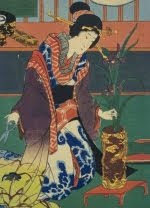One of the most spectacular sights of spring in Oslo, is the blooming of the Magnolia trees in the Botanical Garden. The
Kobushi magnolias are blooming with a cloud of white flowers on bare branches. I can see them from my balcony, and they always put me in a good mood.
When preparing for the demonstration at the Botanical garden a few weeks ago, I wanted to use some of the signature plants of the gardens. I thought to myself that had it been spring, I would definitely have used the Kobushi Magnolia. When I was walking through the gardens to look for materials, I found to my surprise a magnolia still in bloom in late August. The
Oyama magnolia or Siebold's magnolia, native to China, Japan, and Korea, is named after the German doctor Philipp Franz von Siebold.
It turned out the Botanical Garden has quite a few spices of Magnolia, such as
Star magnolia,
Saucer magnolia,
Cucumber magnolia,
White champaca, and
Umbrella magnolia. And in the green houses you can find the tropical Magnolia maudiae.
The Oyama magnolia found it's way to a Chabana arrangement placed in the entrance hall of the Botanical museum. It was just perfect the day of the demonstration. Half way open it demonstrated the very moment of here and now, the moment when the flower is opening. I wasn't able to photograph it until later, when the flower was totally open and on it's way to withering. On the other side, at this state you can see the beautiful red stamens contrasting the white petals and the freshly green leaves.





